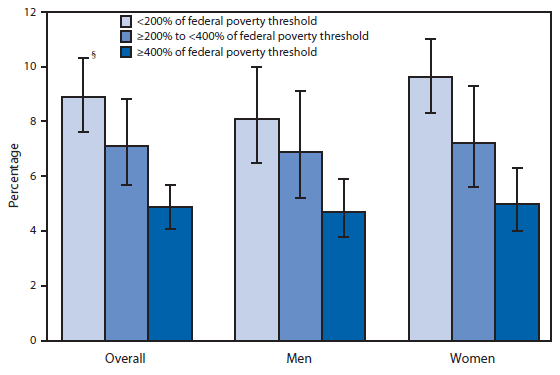QuickStats: Use of Prescription Opioid Analgesics* in the Preceding 30 Days Among Adults Aged ≥20 Years, by Poverty Level† and Sex — National Health and Nutrition Examination Survey, United States, 2007–2012

* During the household interview, respondents were asked, "In the past 30 days, have you used or taken medication for which a prescription is needed?" Those who answered affirmatively were asked to give their prescription medication containers to the interviewer, who then recorded the exact product name from the container's label. Opioid analgesics are commonly prescribed for treating pain caused by surgery, injury, or health conditions such as cancer. Common opioid analgesics include hydrocodone, oxycodone, and methadone.
† Poverty level was based on the family income to poverty ratio, which is the ratio of family income to the poverty threshold after accounting for inflation and family size. A ratio of 1.00 was considered representative of a poverty level at 100% of the federal poverty guideline.
§ 95% confidence interval.
During 2007–2012, use of opioid analgesics in the United States decreased with increasing income; 8.9% of adults aged ≥20 years who had family incomes <200% of the federal poverty threshold used an opioid analgesic in the preceding 30 days, compared with 7.1% of those with incomes 200%–399% of the poverty threshold and 4.9% of those with incomes ≥400% of the poverty threshold. The relationship between income and opioid use was observed for both men and women. Within each of the family income categories, there were no significant differences in opioid analgesic use between men and women.
Source: Frenk SM, Porter KS, Paulozzi LJ. Prescription opioid analgesic use among adults: United States, 1999–2012. NCHS data brief no. 189; 2015. Available at http://www.cdc.gov/nchs/data/databriefs/db189.htm.
Reported by: Steven M. Frenk, PhD, sfrenk@cdc.gov, 301-458-4096; Kathryn S. Porter, MD, Leonard J. Paulozzi, M.D.
Alternate Text: The figure above is a bar chart showing that, during 2007-2012, use of opioid analgesics in the United States decreased with increasing income; 8.9% of adults aged ≥20 years who had family incomes <200% of the federal poverty threshold used an opioid analgesic in the preceding 30 days, compared with 7.1% of those with incomes 200%-399% of the poverty threshold and 4.9% of those with incomes ≥400% of the poverty threshold. The relationship between income and opioid use was observed for both men and women. Within each of the family income categories, there were no significant differences in opioid analgesic use between men and women.
Use of trade names and commercial sources is for identification only and does not imply endorsement by the U.S. Department of
Health and Human Services.
References to non-CDC sites on the Internet are
provided as a service to MMWR readers and do not constitute or imply
endorsement of these organizations or their programs by CDC or the U.S.
Department of Health and Human Services. CDC is not responsible for the content
of pages found at these sites. URL addresses listed in MMWR were current as of
the date of publication.
All MMWR HTML versions of articles are electronic conversions from typeset documents.
This conversion might result in character translation or format errors in the HTML version.
Users are referred to the electronic PDF version (http://www.cdc.gov/mmwr)
and/or the original MMWR paper copy for printable versions of official text, figures, and tables.
An original paper copy of this issue can be obtained from the Superintendent of Documents, U.S.
Government Printing Office (GPO), Washington, DC 20402-9371;
telephone: (202) 512-1800. Contact GPO for current prices.
**Questions or messages regarding errors in formatting should be addressed to
mmwrq@cdc.gov.


